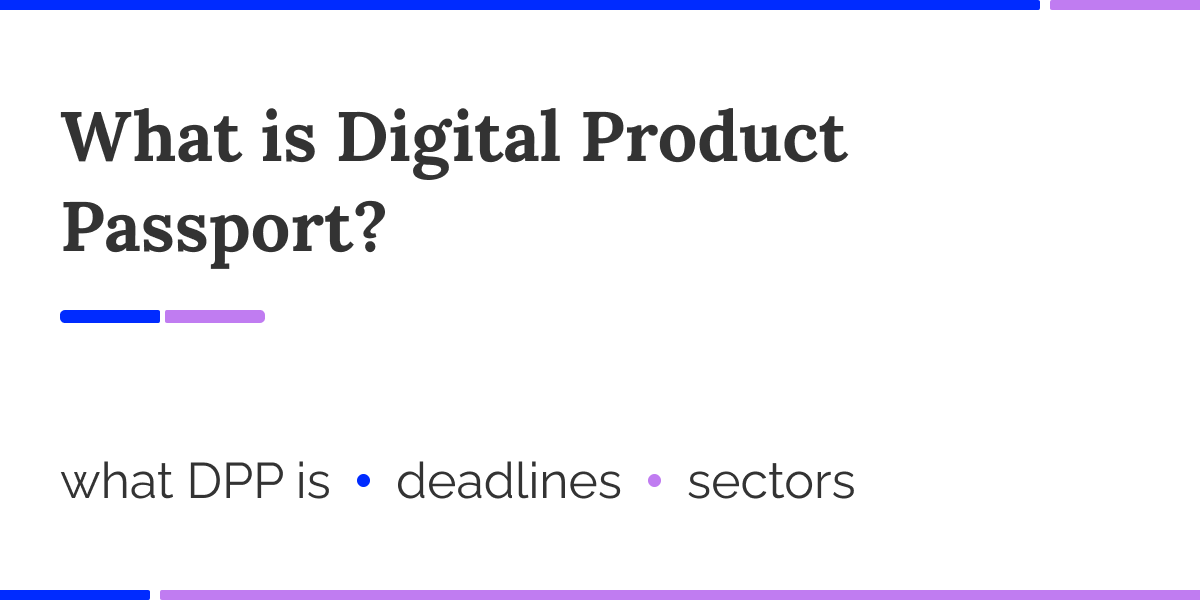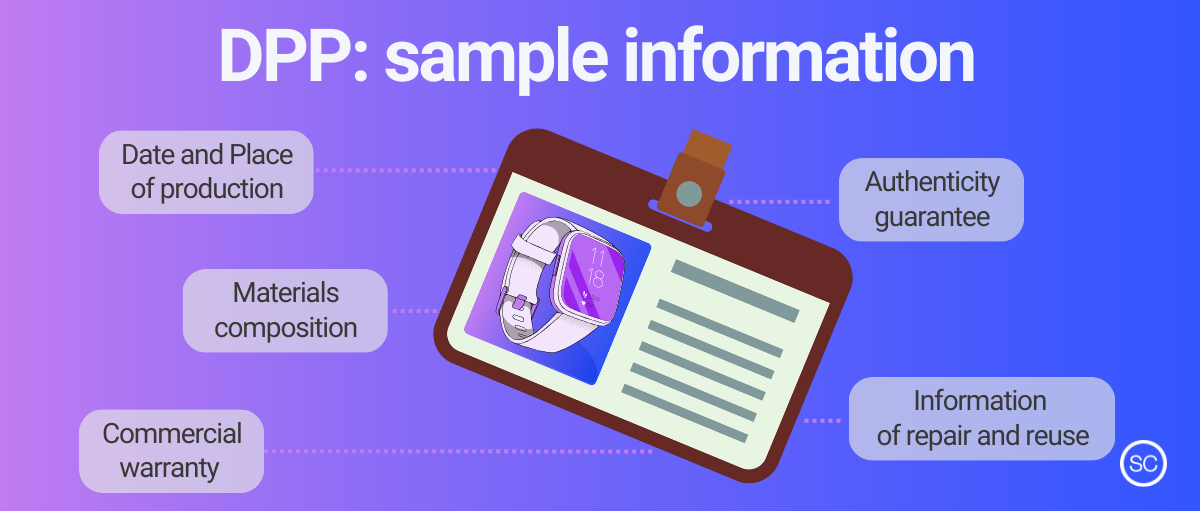
Digital Product Passport: the EU regulation explained easy

Between now and 2030, the EU ESPR Regulation will come into force, which, among other measures, includes the Digital Product Passport (or DPP).
What is the Digital Product Passport? What sectors does it cover? What impacts will it bring with it? In this article we take stock of the situation.
Digital Product Passport: what is the DPP
Let’s get straight to the point.
The acronym DPP stands for Digital Product Passport is a digital register containing a variety of information related to the value chain of an item.
Soon, European companies will have to accompany each product with a detailed list of data on its lifecycle, from production to recycling, through repairability and disposal.
Digital Product Passport: how does it work?
The fruition of DPPs will be clearer from the moment they see their full implementation, but it is likely that standards already in the market such as QR codes will be exploited to access a product’s digital passport.
Once scanned, the code will return to the consumer a set of detailed data on materials, composition, production cycle, varying from sector to sector.
What are Digital Product Passports for?
To understand the purpose of the digital passport produced, it should be mentioned that it is part of the ESPR regulation, approved in spring 2024.
ESPR stands for Ecodesign for Sustainable Product Regulation, a regulation that is part of the Green Deal, a package of EU initiatives to reduce emissions by at least 55 percent by 2030.
ESPR’s focus is to extend eco-design to most products on the EU market in order to reduce the environmental impact of their lifecycle, as is already the case with household appliances.
In addition, ESPR introduces new requirements and standards regarding durability, reparability, energy efficiency and recycling of items in order to counter planned obsolescence and promote circularity.
In this context, the DPP will serve as an informational reference point:
- for companies, which will have a lever of objective and concrete transparency
- for consumers to make more informed and green choices
- for the authorities-who by receiving the data to display in their portals-will be facilitated in controls and increase consumer confidence.
… okay but what about the competition?
Indeed, in the free market, companies’ duties of transparency may collide with the protection of competition.
The broad informational scope of the DPP, could compromise the confidentiality of strategic data, such as those related to production and procurement flows.
For this reason, the Legislature clarified that of all the information included in the DPP, only some will be accessible to consumers, while others will be accessible only by parties witha “legitimate interest,” as determined by the Regulation itself or by the Commission.

When will the Digital Product Passport be mandatory?
At least two steps are planned before the DPPs come into effect:
- the European Commission will present a three-year work plan in 2025, establishing the types of products affected by the regulation
- defined the types of products, a delegated act will be made for each of them, which will enshrine what data each sector must adhere to.
In general, the Digital Product Passport will become mandatory from 2027 for most industries, although there are exceptions.
Digital product passport: starting with batteries
From an initial analysis by the European Commission, the product categories first affected by the new Digital Product Passport appeared to be batteries, textiles, electronics and construction.
As of today, for one of them, the obligation is already fixed.
From 1 February 2027, in fact, battery companies for electric vehicles will have to provide – for every item with a capacity greater than 2kWh – a DPP with information on durability, performance and CO2 impact.
The EU has set up a single electronic battery register, in which the various digital product passports will converge for surveillance purposes.
Which sectors will be obliged to the digital product passport next?
A new study of the European Commission carried out at the end of 2024 by the Joint Research Centre, has identified the next product categories for which the digital product passport obligation is likely to be triggered:
- among final products: clothing, textiles and footwear, furniture, tyres, personal and household care and hygiene products, cosmetics, toys, paints, mattresses;
- among semi-finished products: basic chemicals, iron, steel, plastics and polymers, glass, pulp and paper.
In general, it is likely that the Digital Product Passport – precisely because of its capillarity objectives – will be extended to any other product sector, with a few exclusions (which will apparently concern foodstuffs, animal feed, vehicles and medicines).
What technology will the Digital Product Passport be based on?
Rumors agree that the technology that will enable the emergence of DPP will be blockchain, which is known to offer a digital infrastructure that provides security, transparency and immutability of every record entered by the various actors in an information chain.
By the way, digital passport in luxury fashion already exists
Fashion, particularly that which occupies the highest end of the market, has always been a forerunner of major digital developments.
Not surprisingly, it has also moved ahead at this juncture, through a consortium and voluntary membership project called Aura Blockchain.
The platform, developed by such giants as LVMH, OTB, Cartier and the Prada Group, offers traceability that shields consumers from counterfeits.
Tod’s, for example, has embedded an NFC (Non-Fungible Token) tag in its Di Bag that leverages the Aura project’s blockchain to return data to the customer-who scans it with his or her smartphone-that attests to the authenticity and provenance of the bag’s materials.

49% of consumers already know what the digital product passport is
It is precisely fashion that appears to be the sector whose consumers are most ready.
Research reported by Forbes shows that half of the industry’s customers are familiar with the Digital Product Passport, who consider it a useful tool to certify brand authenticity (56%).
DPP: will companies need ad hoc software?
The management of DPP is closely related to that of product information and, in particular, its centralization, enrichment and delivery.
In view of the new obligation, it is clear that companies that are unstructured from a Product Information Management point of view will be able to seize the opportunity to equip themselves with PIM software-or better yet, PXM software.
Conversely, companies that have already embarked on such digital paths will need to ensure that the tools in use support the management and propagation of DPP data.
Our platform, for example, is SaaS, offers a hyper-flexible data model, and, thanks to APIs, delivers product content (data and media) across any channel. Key features to comply with future DPP obligations.
From regulatory obligation to business opportunity
DPPs are much more than a regulatory requirement.
Digital Product Passports, in fact, can be a useful tool for sharing information and documents that enrich the product experience through certified attestations of a brand’s quality authenticity.
It is also a democratic tool for promoting sustainability actions because the data travels on a third-party-guaranteed circuit, making it easier to detect greenwashing phenomena.
Last but not least, it can facilitate the sale of additional services or products such as repair, disposal, maintenance and repair items.
Get a preview of news about DPP (and more)
Sign up for our newsletter-you will receive it spam-free once a month.
All you have to do is enter your name and business e-mail address. Easy, right?